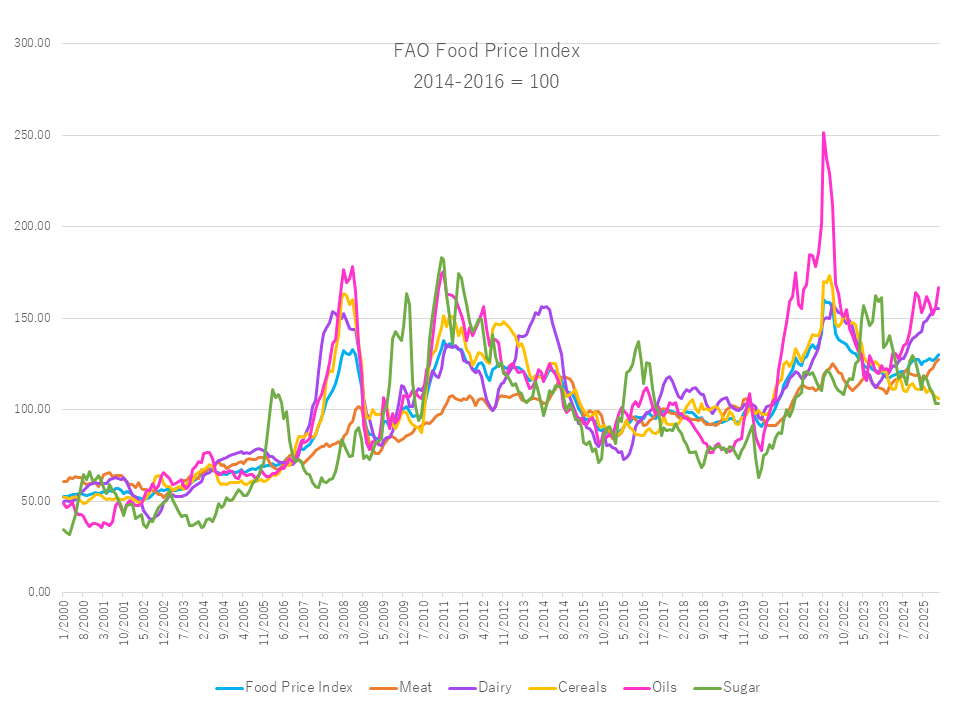Pick Up
1317. World Food Price Trends, July 2025

1317. World Food Price Trends, July 2025
The Food and Agriculture Organization of the United Nations (FAO) released its Food Price Index report on August 8. The average for July 2025 was 130.1 points, up 1.6% from June. Declines in the cereal, dairy, and sugar price indexes were more than offset by increases in the meat and vegetable oil price indexes. Overall, the price index increased 7.6% compared to July last year, but remained 18.8% below its peak in March 2022.
The Cereals Price Index averaged 0.8% lower in July than in June and 3.8% lower than in July 2024. World export prices for barley and corn increased, while those for sorghum and wheat declined. Abundant seasonal supplies due to the ongoing winter wheat harvest in the Northern Hemisphere put downward pressure on prices. However, below-average spring wheat harvest conditions in parts of North America and farmer reluctance to sell in Europe and the Black Sea region provided some support for prices. Meanwhile, international corn prices were supported by reduced farmer willingness to sell, dry weather in parts of Eastern Europe and Ukraine, and reduced exports from Argentina and Brazil (due to export taxes and increased domestic demand, respectively). Meanwhile, the rice price index fell 1.8% in July 2025 due to abundant exportable supplies and weak import demand.
The Vegetable Oil Price Index rose 7.1% from the previous month, reaching its highest level in three years. This increase was driven by higher palm oil, soybean oil, and sunflower oil prices, which more than offset the decline in rapeseed oil prices. International palm oil prices rose for the second consecutive month in July, primarily due to continued strong global import demand, driven by improved price competitiveness relative to other vegetable oils. Meanwhile, soybean oil prices were supported by the outlook for strong feedstock demand from the biofuel sector in the Americas, while sunflower oil prices rose due to seasonal supply constraints in the Black Sea region.
The Meat Price Index rose 1.2% from June and 6.0% from July last year, reaching a new record high. The increase was primarily driven by higher beef and lamb prices and a slight increase in poultry prices, while pork prices declined. Global beef prices reached a new record high, supported by higher prices in Australia. This was supported by strong import demand, particularly from China and the United States, which exceeded export supply. Strong global demand also contributed to higher prices in Brazil. Lamb prices rose significantly for the fourth consecutive month, reflecting limited export supply from Oceania amid sustained global demand. Chicken prices rose slightly, driven by higher Brazilian export prices following the easing of restrictions and the gradual resumption of imports by several major trading partners following Brazil's regaining of its highly pathogenic avian influenza (HPAI)-free status in mid-June. Pork prices, on the other hand, fell primarily due to weaker prices in the European Union (EU), where domestic supplies were abundant but global purchasing interest was weak. The Dairy Price Index was down 0.1% from June but 21.5% higher than July 2024. The slight decline since April 2024 was due to lower international prices for butter and milk powder, largely offset by continued increases in cheese estimates.
The Sugar Price Index fell 0.2% from the previous month, its fifth consecutive month of decline, and is now 13.5% lower than July 2024 levels. Early forecasts suggest that global sugar production is likely to recover in 2025/26, driven by expectations of increased production in India and Thailand and benefiting from a strong economic outlook in the United States.
Contributor: IIYAMA Miyuki, Information Program
